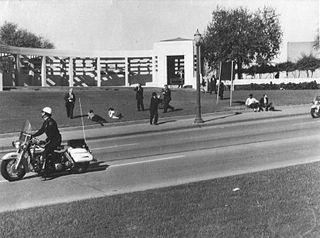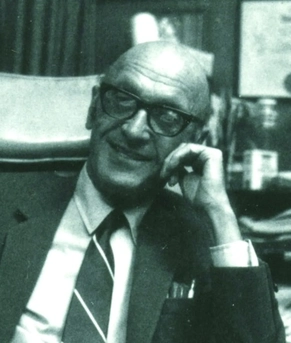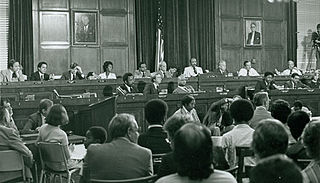Related Research Articles

The President's Commission on the Assassination of President Kennedy, known unofficially as the Warren Commission, was established by President Lyndon B. Johnson through Executive Order 11130 on November 29, 1963, to investigate the assassination of United States President John F. Kennedy that had taken place on November 22, 1963.

John F. Kennedy, the 35th president of the United States, was assassinated on Friday, November 22, 1963, at 12:30 p.m. CST in Dallas, Texas, while riding in a presidential motorcade through Dealey Plaza. Kennedy was in the vehicle with his wife, Jacqueline, Texas Governor John Connally, and Connally's wife, Nellie, when he was fatally shot from the nearby Texas School Book Depository by Lee Harvey Oswald, a former US Marine. The motorcade rushed to Parkland Memorial Hospital, where Kennedy was pronounced dead about 30 minutes after the shooting; Connally was also wounded in the attack but recovered. Vice President Lyndon B. Johnson assumed the presidency upon Kennedy's death.

Norma Jean Lollis Hill was an eyewitness to the assassination of United States President John F. Kennedy in Dallas, Texas, on November 22, 1963. Hill was known as the "Lady in Red" because of the long red raincoat she wore that day, as seen in Abraham Zapruder's film of the assassination. A teacher by profession, she was a consultant for Oliver Stone's 1991 film JFK and co-wrote JFK: The Last Dissenting Witness with Bill Sloan.

The "umbrella man", identified by the United States House Select Committee on Assassinations in 1978 as Louie Steven Witt, is a name given to a figure who appears in the Zapruder film, and several other films and photographs, near the Stemmons Freeway sign within Dealey Plaza during the assassination of United States President John F. Kennedy.

The single-bullet theory, often derided by referring to it as the magic-bullet theory, was introduced by the Warren Commission in its investigation of the assassination of U.S. President John F. Kennedy to explain what happened to the bullet that struck Kennedy in the back and exited through his throat. Given the lack of damage to the presidential limousine consistent with it having been struck by a high-velocity bullet, and the fact that Texas Governor John Connally was wounded and was seated on a jumper seat 1+1⁄2 feet in front of and slightly to the left of the president, the Commission concluded they were likely struck by the same bullet.

Abraham Zapruder was a Ukrainian-born American clothing manufacturer who witnessed the assassination of United States President John F. Kennedy in Dallas, Texas, on November 22, 1963. He unexpectedly captured the shooting in a home movie while filming the presidential limousine and motorcade as it traveled through Dealey Plaza. The Zapruder film is regarded as the most complete footage of the assassination.
The Babushka Lady is an unidentified woman present during the 1963 assassination of US President John F. Kennedy who might have photographed or filmed the events that occurred in Dallas's Dealey Plaza at the time President John F. Kennedy was shot. Her nickname arose from the headscarf she wore, which was similar to scarves worn by elderly Russian women.

The United States House of Representatives Select Committee on Assassinations (HSCA) was established in 1976 to investigate the assassinations of John F. Kennedy and Martin Luther King, Jr. in 1963 and 1968, respectively. The HSCA completed its investigation in 1978 and issued its final report the following year, which concluded that Kennedy was probably assassinated as a result of a conspiracy. In addition to now-discredited acoustic analysis of a police channel dictabelt recording, the HSCA also commissioned numerous other scientific studies of assassination-related evidence that corroborate the Warren Commission's findings.
Rosemary Willis was a close witness during the assassination of United States President John F. Kennedy.

The Dal-Tex Building is a seven-story office building located at 501 Elm Street in the West End Historic District of downtown Dallas, Texas, United States. The building is located on the northeast corner of Elm and North Houston Streets, across the street from the Texas School Book Depository in Dealey Plaza, the scene of the assassination of U.S. President John F. Kennedy on November 22, 1963. The Dal-Tex Building, sometimes called the Dallas-Textiles Building, the Dal-Tex Market Building, or the Dal-Tex Mart Building, was a center of the textile business in Dallas.
Robert J. Groden is an American author who has written extensively about conspiracy theories regarding the assassination of U.S. President John F. Kennedy. His books include The Killing of a President: The Complete Photographic Record of the JFK Assassination, the Conspiracy, and the Cover-up; The Search for Lee Harvey Oswald: A Comprehensive Photographic Record; and JFK: The Case for Conspiracy. Groden is a photo-optics technician who served as a photographic consultant for the House Select Committee on Assassinations.
David Samuel Lifton was an American author who wrote the 1981 bestseller Best Evidence: Disguise and Deception in the Assassination of John F. Kennedy, a work that puts forth evidence that there was a conspiracy to assassinate John F. Kennedy.
Orville Orhel Nix was a witness to the assassination of United States President John F. Kennedy in Dallas, Texas on November 22, 1963. His filming of the shooting, which only captured the last few seconds of it, is considered to be nearly as important as the film by Abraham Zapruder.
Marie M. Muchmore was one of the witnesses to the assassination of United States President John F. Kennedy in Dallas, Texas, on November 22, 1963. A color 8 mm film that Muchmore made is one of the primary documents of the assassination. The Muchmore film, with other 8 mm films taken by Abraham Zapruder and Orville Nix, was used by the Warren Commission to investigate the assassination and to position the presidential limousine in a forensic recreation of the event in May 1964.
Marilyn Sitzman was an American receptionist and a witness to the assassination of United States President John F. Kennedy in Dallas, Texas, on November 22, 1963. She was with her boss, Abraham Zapruder, as he made the Zapruder film, the most studied record of the assassination.
The John F. Kennedy assassination and the subsequent conspiracy theories surrounding it have been discussed, referenced, or recreated in popular culture numerous times.

The Zapruder film is a silent 8mm color motion picture sequence shot by Abraham Zapruder with a Bell & Howell home-movie camera, as United States President John F. Kennedy's motorcade passed through Dealey Plaza in Dallas, Texas, on November 22, 1963. It captured the assassination of the President.
Richard E. Sprague was an American computer technician, researcher and author. According to American journalist Richard Russell, who dedicated seventeen years to the investigation of John Kennedy assassination, Sprague was "the leading gatherer of photographic evidence about the Kennedy assassination". Sprague published his investigation in 1976-1985 as three editions of The Taking of America, 1-2-3.

The assassination of President John F. Kennedy on November 22, 1963 spawned numerous conspiracy theories. These theories allege the involvement of the CIA, the Mafia, Vice President Lyndon B. Johnson, Cuban Prime Minister Fidel Castro, the KGB, or some combination of these individuals and entities. The original FBI investigation and Warren Commission report, as well as an alleged "benign CIA cover-up", have led to the claim that the federal government deliberately covered up crucial information in the aftermath of the assassination. Former Los Angeles District Attorney Vincent Bugliosi estimated that a total of 42 groups, 82 assassins, and 214 people had been accused at one time or another in various conspiracy scenarios.

The three tramps are three men photographed by several Dallas-area newspapers under police escort near the Texas School Book Depository shortly after the assassination of United States President John F. Kennedy on November 22, 1963. Since the mid-1960s, various allegations have been made about the identities of the men and their involvement in a conspiracy to kill Kennedy.
References
- ↑ Hoover, Bob (December 28, 1991). "Turning the page on JFK". Pittsburgh Post-Gazette. Pittsburgh, Pennsylvania. p. 16. Retrieved August 16, 2014.
- ↑ Trillin, Calvin (November 3, 1967). "The Buffs". The New Yorker. New York. Retrieved November 30, 2020.
- ↑ "Harold Lipset: Biography". ETHW: The Engineering and Technology History Wiki. Retrieved 3 July 2022.
- ↑ Thompson, Josiah (1988). Gumshoe: Reflections in a Private Eye. Boston: Little, Brown.
- ↑ Trillin, Calvin (1978-11-27). "Tink". The New Yorker.
- ↑ Bronstein, Phil (9/29/2020). "Last Call for Gumshoes". Alta. San Simeon Films. Retrieved 14 December 2020.
- ↑ Simkin, John. "Josiah Thompson". Spartacus Educational. Spartacus Educational Publishers. Retrieved 14 December 2020.
- ↑ Rosenfield, Seth (28 February 1999). "A dividing driveway". SFGate. San Francisco Examiner. Retrieved 14 December 2020.
- ↑ Rosenfeld, Seth (27 May 2003). "New life for cemetery, better days for Bolinas". SFGate. San Francisco Examiner. Retrieved 14 December 2020.
- ↑ "Lis Thompson Fuchs". Legacy.com. Retrieved 14 December 2020.
- ↑ Klein, Gary. "Marin Snapshot: San Rafael private eye puts his focus on defense work (3/11/2016)". Marin Independent Journal. Retrieved 14 December 2020.
- ↑ Kleiner, Dick (February 1, 1968). "3 Fired at Kennedy". The Times-News. Hendersonville, North Carolina. NEA. p. 3. Retrieved September 20, 2014.
- ↑ Winship, Frederick M. (November 17, 1967). "Study Of Assassination Claims Conspiracy By Trio". The Bryan Times. Bryan, Ohio. UPI. pp. 1–2. Retrieved April 11, 2015.
- ↑ Updike, John. "Notes and Comment". The New Yorker. Retrieved 14 December 2020.
- ↑ Cases, Copyright. "Time Inc. v. Bernard Geis Assocs". Legal Information Institute. Cornell University. Retrieved 26 October 2015.
- ↑ "Time Inc. v. Bernard Geis Assoc., 293 F. Supp. 130 (S.D.N.Y. 1968)". Justia.
- ↑ "Last Second in Dallas". University Press of Kansas. Retrieved 15 November 2020.
- ↑ Thompson, Josiah (15 February 2021). Last Second in Dallas. ISBN 978-0700630080.
- ↑ "Passing the Torch: Last Second in Dallas". History Exhumed. Cyril H. Wecht Institute of Forensic Science and Law. Retrieved 3 August 2020.
- ↑ Morris, Errol (November 21, 2011). "'The Umbrella Man'". The New York Times. New York. Retrieved May 11, 2015.
- ↑ Morris, Errol (director); Josiah Thompson (interviewee) (November 22, 2011). The Umbrella Man (documentary film). New York: The New York Times. Retrieved May 11, 2015.
- ↑ Michaud, Jon (November 22, 2011). "Updike, J.F.K., and the Umbrella Man". The New Yorker. New York. Retrieved May 11, 2015.